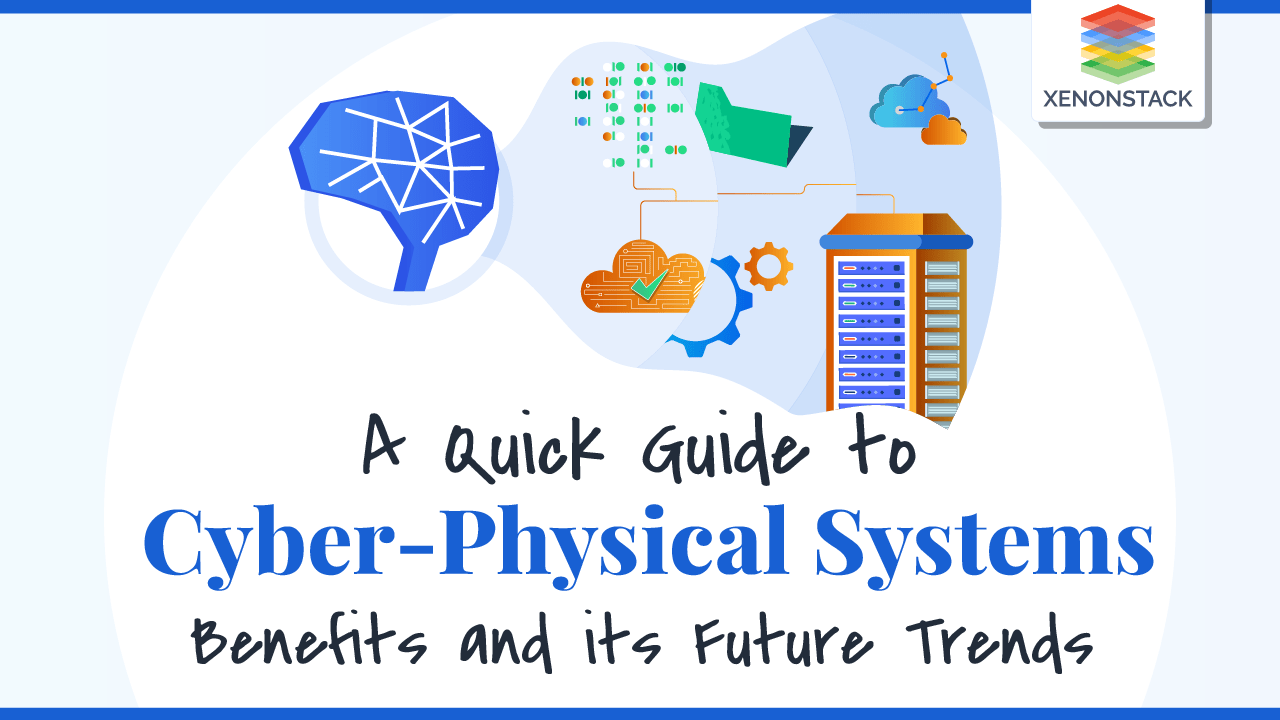
Introduction to Cyber-Physical Systems
Systems that combine computing, communication, and control capabilities with physical procedures and elements are known as cyber-physical systems (CPS). These systems can be considered part of a broader cyber-physical architecture, where computational components are tightly integrated with physical processes. Numerous industries use these systems, such as manufacturing, transportation, healthcare, and energy. IoT (Internet of Things) and real-time monitoring are integral components that ensure effective interaction between physical and digital environments, allowing businesses to streamline processes and enhance efficiency. As a result, businesses can streamline their processes and improve their systems' effectiveness and dependability.
Examples of CPS include:
-
Industrial Control Systems
-
Smart Grids (which fall under smart infrastructure)
-
Autonomous Vehicles (linked to autonomous systems)
CPS integrates multiple technologies and components and requires effective design and management. Observability is an essential aspect of it, as it allows organizations to monitor and understand the behavior of these systems and identify any issues or bottlenecks that may arise. By implementing monitoring and analysis tools, organizations can gain insight into their performance and behavior and take action to optimize or improve them.
A common platform for all devices to dump their data for all the devices to communicate with each other in a common language. Click to explore about our, IoT Workings and Its Operations
A Comprehensive Look at Cyber-Physical Systems
Cyber-Physical Systems (CPS) are advanced systems that integrate computational elements with physical processes. They leverage technologies such as IoT (Internet of Things) and real-time monitoring to create intelligent environments where devices can communicate and operate autonomously. CPS is essential in various industries, including manufacturing, healthcare, and smart infrastructure, enabling enhanced efficiency and safety through data analytics and machine learning.
Key Challenges in Cyber-Physical Systems Implementation
Despite their potential, Cyber-Physical Systems face several challenges:
-
Cybersecurity measures: As CPS becomes more interconnected, they are increasingly vulnerable to cyber threats. Implementing robust cybersecurity measures is essential to safeguard safety-critical systems.
-
Interoperability: Integrating various technologies and platforms into a cohesive Cyber-Physical architecture often presents compatibility issues.
-
Scalability: Ensuring that CPS can grow and adapt to new demands without compromising performance is crucial for long-term success.
-
Safety-Critical Systems: Many CPS operate in environments where failures can have significant consequences, necessitating robust safety protocols and real-time feedback loops.
Retrieve the affected systems, examine the attack's root causes, and improve the security system. Click to explore about our, Artificial Intelligence in CyberSecurity
Steps for Adopting Cyber-Physical Systems in Organizations
There are several steps that an organization can take to adopt cyber-physical systems:
-
Identify the business needs: Identify the specific needs it can help address. This may involve analyzing current processes and identifying areas, such as real-time monitoring and control systems, where it can improve efficiency, reliability, or safety.
-
Assess the feasibility: Consider the feasibility of integrating IoT (Internet of Things) and edge computing for real-time decision-making and system control.
-
Define the requirements: Once you have identified the business needs and assessed the feasibility of implementing it, define the specific requirements for the system. This includes identifying machine learning capabilities for system optimization.
-
Design the system: Based on your defined requirements, design the CPS architecture. This may involve choosing and integrating the appropriate components and technologies and designing the control and communication systems that will monitor and control the physical processes.
-
Implement and test the system: After it has been designed, implement and test it using data analytics to ensure it is functioning as intended. This may involve conducting pilot tests or simulations to validate the system's performance and reliability.
-
Deploy and monitor the system: Once it has been implemented and tested, deploy it in your organization and begin real-time monitoring it to ensure it performs as expected. This may involve implementing monitoring and analysis tools to help you understand and optimize its performance.
By following these steps, organizations can successfully adopt CPS and realize the benefits of real-time monitoring and control of physical processes.
Behavior Anomaly detection provides real-time detection of cyber attack threats. Click to explore about our, Anomaly Detection in Cyber Network Security
Industry Applications and Use Cases for CPS
There are many industry use cases for cyber-physical systems, including:
-
Manufacturing: Cyber-physical systems are used to optimize manufacturing production processes by monitoring and controlling machinery in real time. For example, an industrial control system can monitor and control the operation of machinery and equipment in real-time.
-
Transportation: Autonomous systems, such as self-driving cars, rely on control systems and IoT to navigate and avoid hazards. It can also be used to optimize public transportation systems, such as buses and trains.
-
Healthcare: IoT devices and real-time monitoring help manage medical devices like ventilators and patient monitoring systems. It can also be used to optimize the operation of hospitals and other healthcare facilities.
-
Energy: Smart grids, part of smart infrastructure, can adapt to energy demands and conditions using real-time monitoring and data from IoT devices.
-
Agriculture: CPS can optimize the operation of agricultural systems, such as irrigation, and monitor crop growth through IoT sensors and control systems.
These are just a few ways it can be used in different industries. CPS can generally be applied to any system where real-time monitoring and control are essential.
Service offerings for Enabling AI driven Cyber Security for Security Intelligence, Operations and Analytics and Vulnerability management Solutions. Click to explore about our, Impact of Artificial Intelligence on Cyber Security
What are the Benefits of Using CPS?
There are several benefits of using cyber-physical systems:
-
Improved Efficiency and Reliability: Organizations can optimize operations, improving system reliability through real-time monitoring and control systems. For example, an industrial control system can monitor and control production processes in real time, reducing waste and improving productivity.
-
Enhanced Safety: Autonomous vehicles and safety-critical systems benefit from real-time monitoring and decision-making using machine learning and data analytics. For example, an autonomous vehicle can use sensors and control systems to avoid collisions and other hazards.
-
Greater Flexibility: CPS provides greater flexibility in how systems are designed and operated. For example, a smart grid can be designed to be more resilient and adaptable to changing energy demands and conditions.
-
Enhanced Monitoring and Control: These systems provide real-time monitoring and control of physical processes, which can help organizations identify and resolve issues more quickly. This can improve the reliability and performance of systems.
Best Practices for Strengthening CPS Security
To maintain a strong AWS security posture, organizations should follow these key best practices:
- Adopt a Zero Trust Architecture: Ensure that all users and devices are continuously verified before granting access.
- Utilize Machine Learning for Threat Detection: Implement algorithms that can identify unusual patterns in data traffic.
- Regularly Update Legacy Systems: Ensure that older systems are patched and updated to protect against vulnerabilities.
- Implement Feedback Loops: Use feedback mechanisms to continuously monitor the performance and security of safety-critical systems.
- Focus on Integration Standards: Establish clear standards for interoperability between different components of CPS.
Emerging Trends Shaping the Future of CPS
Several trends are shaping the future of cyber-physical systems:
-
Increased integration with the Internet of Things (IoT): As Cyber-Physical Systems continue to evolve, they will integrate more deeply with IoT (Internet of Things), allowing for smarter, more efficient operations across industries. This allows CPS to collect and analyze data from a wide range of sources, which can improve the accuracy and effectiveness of the system.
-
Greater use of artificial intelligence (AI) and machine learning (ML): AI and ML capabilities are beginning to be incorporated to enable more advanced data analysis and decision-making. This can help it to adapt to changing conditions and optimize its performance more effectively.
-
Increased adoption of cloud-based CPS: There has been a trend towards the adoption of cloud-based CPS, which can provide greater scalability and flexibility than on-premises systems.
-
Greater focus on security and privacy: As the importance of data security and privacy continues to grow, attention is increasingly being paid to cybersecurity measures to protect data and safety-critical systems from emerging threats.
Overall, the future looks bright, with a growing focus on integration with the IoT, the incorporation of AI and ML capabilities, and increased attention to security and privacy.

Key Takeaways on Cyber-Physical Systems
Cyber-Physical Systems (CPS) provide significant advantages to organizations, including improved efficiency and reliability through real-time monitoring and control of processes. These systems enhance safety by enabling rapid response to potential hazards in critical environments like healthcare, energy, and transportation. CPS also offers greater flexibility, allowing systems to scale and adapt to changing needs, whether by integrating new technologies or expanding capabilities. Additionally, enhanced monitoring and control help organizations optimize performance and reduce risks. By adopting CPS, organizations can achieve better operational performance, minimize downtime, and ensure long-term resilience. As industries continue to evolve, the value of CPS will grow, driving innovation, efficiency, and safety across sectors.
How to Proceed with Adopting Cyber-Physical Systems
Consult with our experts to explore how Cyber-Physical Systems (CPS) can be implemented to transform your operations. Discover how various industries and departments use CPS to enhance decision-making, improve real-time monitoring, and optimize workflows. Leverage advanced technologies to automate and streamline processes, boosting efficiency, safety, and responsiveness in your systems.
.webp?width=1921&height=622&name=usecase-banner%20(1).webp)


